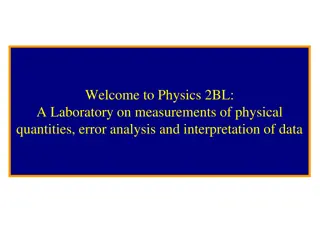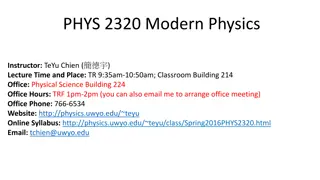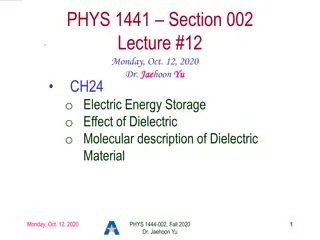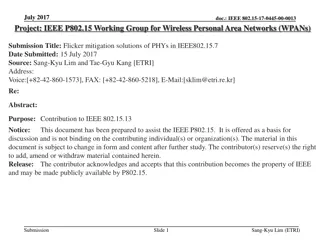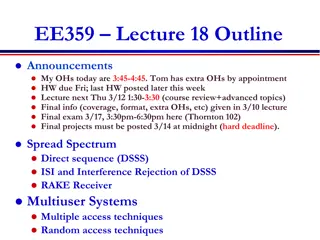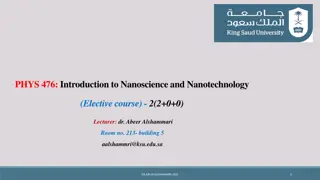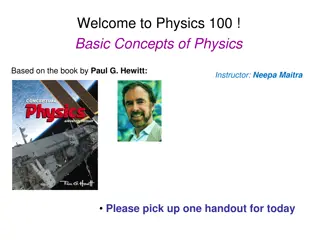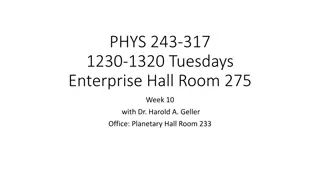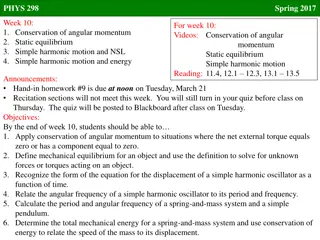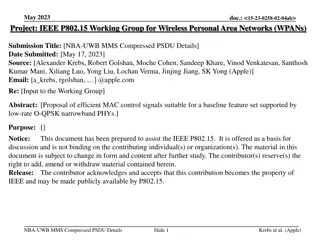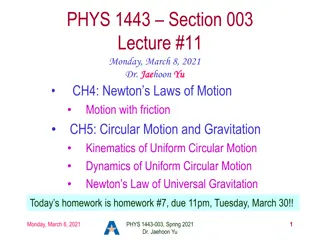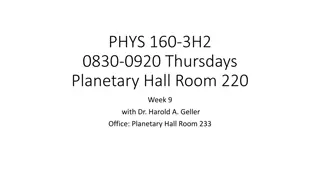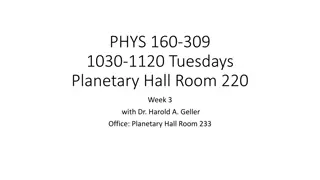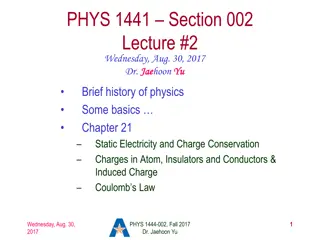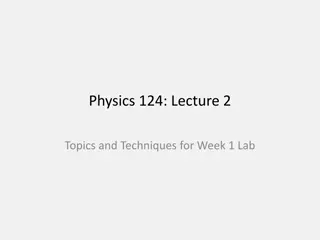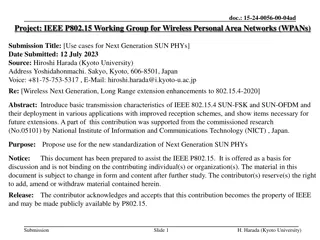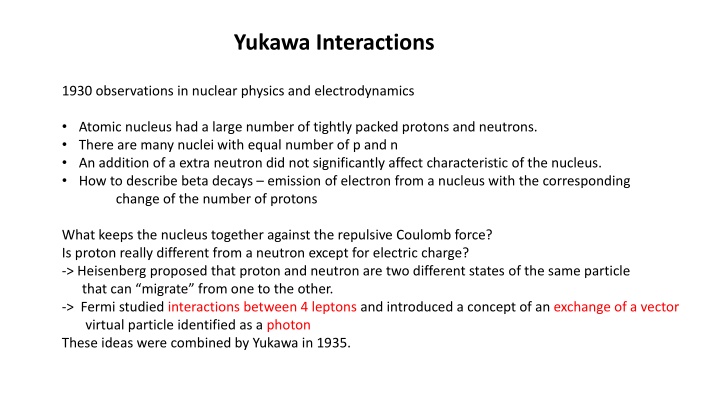
Yukawa Interactions in Nuclear Physics and Electrodynamics
Explore the 1930 observations in nuclear physics and electrodynamics by Yukawa, proposing interactions between protons and neutrons mediated by a scalar particle, leading to the concept of the exchange of virtual photons. Understand the significance of the Yukawa potential, gauge invariance, and the fundamental forces at play within atomic nuclei.
Uploaded on | 0 Views
Download Presentation

Please find below an Image/Link to download the presentation.
The content on the website is provided AS IS for your information and personal use only. It may not be sold, licensed, or shared on other websites without obtaining consent from the author. If you encounter any issues during the download, it is possible that the publisher has removed the file from their server.
You are allowed to download the files provided on this website for personal or commercial use, subject to the condition that they are used lawfully. All files are the property of their respective owners.
The content on the website is provided AS IS for your information and personal use only. It may not be sold, licensed, or shared on other websites without obtaining consent from the author.
E N D
Presentation Transcript
Yukawa Interactions 1930 observations in nuclear physics and electrodynamics Atomic nucleus had a large number of tightly packed protons and neutrons. There are many nuclei with equal number of p and n An addition of a extra neutron did not significantly affect characteristic of the nucleus. How to describe beta decays emission of electron from a nucleus with the corresponding change of the number of protons What keeps the nucleus together against the repulsive Coulomb force? Is proton really different from a neutron except for electric charge? -> Heisenberg proposed that proton and neutron are two different states of the same particle that can migrate from one to the other. -> Fermi studied interactions between 4 leptons and introduced a concept of an exchange of a vector virtual particle identified as a photon These ideas were combined by Yukawa in 1935.
Yukawa proposed a potential between proton and neutron that was a modified Coulomb potential mediated by an exchange of the spin 0 particle. He estimated the mass of such particle needed to keep the nucleus together to be ~200 MeV. It was in 1950ties identified with a pion (mass ~140 MeV). If two particle interact via exchange of a scalar particle of mass , the potential between them is: V(r) = -g2 1 re-mr ?2 4?? 1 ?? ?? ? ? = To avoid confusion coupling is sometimes denoted by g 4p Similar to Coulomb potential except for the sign (attraction) and exponential factor limiting the range of interactions. Negative sign gives final range. In quantum theory, the exchange of even spin always gives an attractive force. Odd spin gives attractive force between opposite charges and repulsive force between like charges Chemistry 101 nuclear forces
Aside: As for other forces, the form of the Yukawa potential has a geometrical interpretation in terms of the field line picture introduced by Faraday : The 1/r part results from the dilution of the field line flux in space. The force is proportional to the number of field lines crossing an elementary surface. Since the field lines are emitted isotropically from the force source and since the distance r between the elementary surface and the source varies the apparent size of the surface as 1/r2, the force also follows the 1/r2 dependence. This is equivalent to the 1/r part of the potential. In addition, the exchanged mesons are unstable and have a finite lifetime. The disappearance of the mesons causes a reduction of the flux through the surface that results in the additional exponential factor e rof the Yukawa potential. Massless particles such as photons are stable and thus yield only 1/r potentials. Note, however, that other massless particles such as gluons or gravitons do not generally yield 1/r potentials because they interact with each other, distorting their field pattern. When this self-interaction is negligible, such as in weak-field gravity or for very short distances for the strong interaction asymptotic freedom, the 1/r potential is restored.
What is gauge Gauge means a measure associated with some dimensions or units related to a measure If a container of a fixed volume contains metal balls, the measurement of a ball diameter is a gauge of the number of ball in that container. Changing the diameter allows us to change the estimate even if we do not count individual numbers of balls (gauge transformation). Painting the balls in different colors does not change their number ->the color exhibits gauge invariance Change of the reference frame e.g., different origin of the axes is gauge invariant (gauge symmetry) Gauge invariant theory does not depend on changing the gauge. This applies also to cases where the fundamental fields cannot be directly measured, but the associated quantities (charge, energy, velocity..) can be observed. Example: In electrodynamics, the electric field E and magnetic field B are observable but the potential V and vector potential A are not. Adding a constant to the potential V (change of reference frame) does not change the value of the field.
Gauge theory and symmetry Noeter s theorem describes the rules for the continuous and discrete quantum number for cases that satisfy a symmetry of the Lie group. In physic a gauge theory is a type of field theory in which Lagrangian does not change under local transformation. Notice the word local local symmetry refers to symmetry that is valid in the neighborhood of a point in space-time (short distance) and can vary from point to point. This is important when one needs a continuity of derivative that is made under an assumption that locally the space time is flat i.e., spatial derivative does not depend on time. This is in contrast to global symmetry that is valid at all points in space-time. In such case a derivative can vary from one space-time point to the next one. Mathematically, special relativity obeys local symmetry while general relativity requires global symmetry. The general, gauge fields are included in the Lagrangian to insure its gauge invariance. When such theory is quantized, the quanta of gauge fields are called gauge bosons. The gauge theories can have symmetry that is non-commutative. An example of non-commutative symmetry is rotation around three orthogonal axes. The change of order of rotation changes the answer. This is particularly important for dealing with spin.
Symmetries are classified in groups when the object/quantity remains invariant under the transformation Examples: Simplest global symmetry U(1) - electric charge Local symmetry depends on position, there particular transformation is applied differently at different points in space time. Global symmetry is the same everywhere (the symmetry parameter is a constant). The group is called abelian if it obeys the commutation law ? ? = ? ? The group of rotations in 3-dimensions is non-abelian since ? ? ? ?


